Coffee grinding is the cornerstone of crafting exceptional coffee, transforming beans into a culinary experience. This guide explores the basics, techniques, and best practices for mastering coffee grinding.
Overview of Coffee Grinding Basics
Coffee grinding involves breaking down coffee beans into smaller particles to release their flavors and oils. The process requires understanding grind size, consistency, and freshness. Key elements include:
- Consistency: Uniform particles ensure balanced extraction.
- Grind Size: Varies by brewing method (e.g., fine for espresso, coarse for French press).
- Freshness: Grinding just before brewing preserves flavor and aroma.
- Bean Origin and Roast: Affects grind quality and flavor profile.
Mastering these basics elevates your coffee experience and ensures optimal flavor extraction.
The Importance of Freshly Ground Coffee
Freshly ground coffee ensures vibrant flavor and aroma, as pre-ground beans lose quality quickly. Grinding just before brewing prevents oxidation, preserving the coffee’s natural oils and essence.
Why Freshness Matters in Coffee Flavor
Freshness is paramount in coffee flavor as it directly impacts aroma, taste, and overall quality. Coffee beans lose their volatile compounds rapidly after grinding, leading to a dull, stale taste. Oxidation, moisture, and heat accelerate this degradation, diminishing the coffee’s natural oils and nuances. Pre-ground beans, exposed to air for extended periods, suffer significant flavor loss. Grinding just before brewing ensures that the beans’ integrity is preserved, delivering a vibrant, balanced cup with distinct notes and a richer sensory experience.
Types of Coffee Grinders
Coffee grinders come in two main types: blade and burr. Blade grinders use spinning blades, while burr grinders crush beans for consistent results. Choose based on convenience or precision.
Blade vs. Burr Grinders: Pros and Cons
Blade grinders are affordable, compact, and easy to clean, making them great for casual use. However, they generate heat, which can degrade beans, and produce inconsistent grinds. Burr grinders, while pricier, offer precise control over grind size and avoid heat damage, making them ideal for coffee enthusiasts. They are durable but require more maintenance and space. Choosing between them depends on your priorities: budget and simplicity vs. precision and quality. Burr grinders are recommended for better flavor and consistency, while blade grinders suit those seeking convenience.
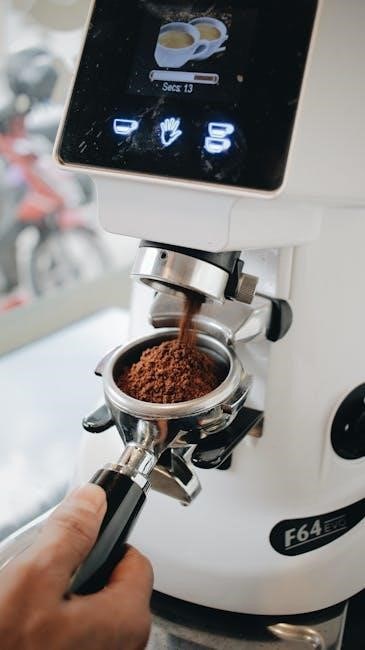
Coffee Bean Origin and Its Impact on Grinding
Coffee bean origin significantly influences grind characteristics. Factors like altitude, soil type, and processing methods affect bean density and moisture, requiring tailored grinding techniques for optimal flavor extraction.
How Bean Origin Affects Grind Quality
Coffee bean origin plays a crucial role in determining grind quality. Beans from high-altitude regions, like Ethiopian Yirgacheffe, are denser and harder, requiring a finer grind for optimal extraction. Conversely, beans from lower altitudes, such as Brazilian Santos, are softer and may need a coarser grind. The moisture content, influenced by processing methods, also impacts grind consistency. For instance, naturally processed beans tend to be more brittle, leading to a more uneven grind compared to washed beans. Understanding these factors ensures a tailored grinding approach for each bean’s unique characteristics, enhancing flavor and aroma in every brew.

Understanding Grind Size and Its Effects
Grind size significantly impacts coffee extraction and flavor. Fine grinds enhance extraction for espresso, while coarse grinds suit French press, making grind size crucial for optimal brewing methods.
How Grind Size Impacts Brewing Methods
Grind size plays a critical role in various brewing methods, as it directly affects extraction rates and flavor profiles. A fine grind is ideal for espresso, ensuring intense extraction under high pressure, while a medium grind suits drip coffee for balanced flavor. Coarse grinds are best for French press and cold brew, allowing oils and sediments to infuse naturally. Adjusting grind size ensures optimal water flow and extraction time, preventing under-extraction or bitterness. Each method demands a specific grind to achieve the perfect cup, making grind size a key factor in brewing success.
Step-by-Step Grinding Guide
Mastering coffee grinding involves measuring beans, adjusting grind size, and ensuring uniformity. Follow these steps for optimal flavor and freshness in every brew.
A Comprehensive Grinding Tutorial
Begin by selecting your coffee beans and grinder type. Measure the beans according to your brew method. Grind the beans to the desired size. Use a burr grinder for consistency. Shake the grinder to ensure even distribution. Transfer grounds to your brewing device. Tamp if necessary. Brew and enjoy. For optimal flavor, grind just before brewing. Clean your grinder regularly to prevent residue buildup. Experiment with grind sizes to suit your brewing method. Store beans properly to maintain freshness. This tutorial ensures a perfect grind every time, enhancing your coffee experience. Always follow safety guidelines when handling grinders.

Tips for Consistent Grinding
Ensure bean freshness, invest in a burr grinder, and adjust grind size based on brewing method. Clean your grinder regularly to prevent residue buildup and maintain flavor consistency.
Ensuring Uniformity in Every Grind
Achieving uniformity in coffee grinding is crucial for consistent flavor. Use a high-quality burr grinder, as it produces evenly sized particles. Regularly clean and calibrate your grinder to maintain precision. Store beans properly to preserve freshness, and grind immediately before brewing. Adjust grind size based on your brewing method—finer for espresso, coarser for French press. Experiment with small batches to refine your technique. Uniform grinds ensure balanced extraction, enhancing the overall coffee experience. Proper maintenance and attention to detail will help you master the art of consistent grinding.
Common Mistakes to Avoid
Avoid using blade grinders, as they generate heat and inconsistently grind beans. Never grind too much coffee at once, and ensure your grinder is clean and well-maintained.
Pitfalls in Coffee Grinding and Solutions
- Inconsistent grind size: Adjust burrs and ensure beans are evenly fed into the grinder.
- Incorrect burr settings: Calibrate your grinder for the desired coarseness or fineness.
- Over-grinding: Grind only what’s needed and store beans properly to maintain freshness.
- Using blade grinders: Opt for burr grinders to avoid heat damage and uneven results.
- Poor maintenance: Clean the grinder regularly and replace burrs as needed for optimal performance.
Health Benefits of Grinding Your Own Coffee
Grinding your own coffee ensures freshness, preserving nutrients and flavors. Freshly ground beans retain more antioxidants, providing potential health benefits like improved heart health and enhanced cognitive function.
Nutritional Advantages of Fresh Grinding
Fresh grinding preserves coffee’s natural nutrients and antioxidants, such as polyphenols, which are often lost in pre-ground beans. Retaining these compounds can enhance potential health benefits, including improved heart health and cognitive function. Freshly ground coffee also maintains its volatile compounds, which contribute to its aroma and flavor. By grinding your own beans, you ensure maximum freshness, allowing you to reap the full nutritional rewards of your coffee. This makes fresh grinding a healthier choice for coffee enthusiasts seeking to enjoy both flavor and wellness benefits in every cup.
Storage and Maintenance of Grinders
Store grinders in a dry, cool place to prevent moisture damage. Regularly clean with a brush or soft cloth, and lubricate moving parts for smooth operation.
Best Practices for Grinder Longevity
To ensure your grinder lasts, clean it regularly with a soft brush or cloth. Store it in a cool, dry place to prevent moisture buildup.
After each use, empty the bean hopper to avoid oil residue. Lubricate moving parts periodically for smooth operation. Burr grinders may need alignment over time.
For blade grinders, avoid overloading to prevent motor strain. Replace worn or dull blades for consistent grinding.
Proper maintenance and care will extend the life of your grinder and ensure optimal performance.
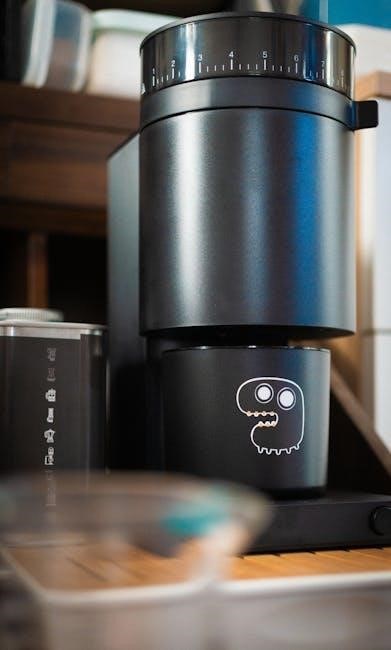
Cleaning and Hygiene Practices
Regularly clean your grinder with a soft brush to remove coffee residue. Wipe surfaces with a damp cloth, avoiding harsh chemicals.
Ensure all parts are dry to prevent rust or mold growth. Cleanliness is key to maintaining flavor and grinder longevity.
Keeping Your Grinder in Prime Condition
To maintain your grinder’s performance, clean it after each use with a soft brush or cloth. Remove residual coffee oils and dust to prevent flavor contamination.
Deep clean monthly by grinding rice or breadcrumbs to absorb oils. Lubricate burrs if needed, and store the grinder in a dry place.
Regular maintenance ensures consistent grind quality and extends the grinder’s lifespan. Avoid harsh chemicals, as they may damage components or leave residues affecting coffee taste.
Troubleshooting Grinder Issues
Common grinder issues include clogged burrs, uneven grinding, and motor overheating. Clean burrs regularly, adjust grind settings, and ensure proper ventilation to resolve these problems effectively.
Diagnosing and Solving Common Problems
Identifying grinder issues starts with observation. If the motor slows, check for blockages or worn burrs. Uneven grinds may indicate a need for calibration or blade replacement. Noise increases could signal dull blades or misalignment. Regular cleaning prevents clogs, while lubricating moving parts ensures smooth operation. For overheating, ensure proper ventilation and avoid overloading. Addressing these problems promptly extends the grinder’s lifespan and maintains consistent grind quality. Always refer to the user manual for specific troubleshooting steps tailored to your grinder model.
Choosing the Right Grinder for Your Needs
Selecting the ideal grinder involves considering brew methods, budget, and lifestyle. Burr grinders offer precision, while blade grinders are affordable. Choose based on your coffee preferences and routine.
Factors to Consider in Grinder Selection
When selecting a grinder, consider grind size consistency, ease of use, and durability. Burr grinders offer precise control, while blade grinders are compact. Budget, noise levels, and maintenance also matter; Choose based on your brewing method and lifestyle. For espresso, a burr grinder is ideal. Doser or doserless options suit different needs. Automatic grinders save time, while manual grinders provide portability. Assessing these factors ensures you find a grinder that enhances your coffee experience. Prioritize features aligning with your daily routine and coffee goals.
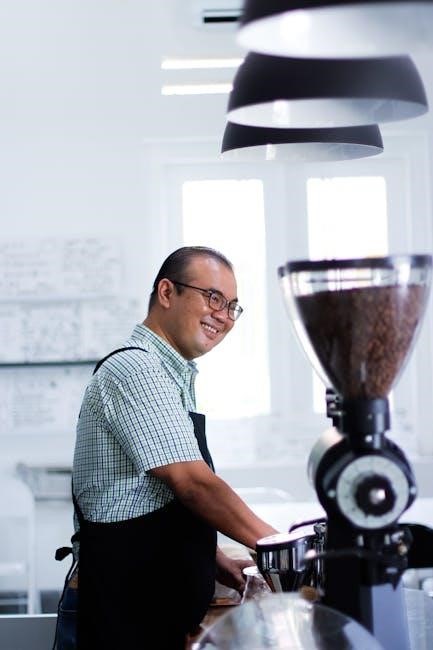
Coffee Grinding for Different Brew Methods
Coffee grinding varies by brew method, with espresso needing fine grinds and French press requiring coarse. Adjusting grind size ensures optimal extraction for each brewing technique.
Optimizing Grind for Various Coffee Drinks
Optimizing grind size is crucial for different coffee drinks. Espresso requires a fine grind for high pressure, while a medium grind suits pour-over and drip brewing. Coarser grinds are ideal for French press and cold brew, allowing for proper extraction without over-extraction. Adjusting the grind ensures balanced flavors and aromas, enhancing the overall quality of each brew. Understanding the right grind size for each method is key to achieving a perfect cup every time, whether it’s a rich espresso or a smooth cold brew.
Advanced Techniques for Expert Grinding
Advanced grinding involves precision techniques like micro-adjustments, using high-end burr grinders, and experimenting with customizable settings to achieve optimal extraction and flavor profiles for expert results.
Mastering the Art of Coffee Grinding
Mastering coffee grinding requires a deep understanding of bean origin, roast levels, and grind size. Precision is key: micro-adjustments can significantly impact flavor. High-end burr grinders offer customizable settings, allowing experts to tailor grinds for specific brewing methods. Experimentation with grind distribution and alignment ensures consistency. Advanced techniques involve tuning grinder calibration and exploring single-origin beans for nuanced profiles. By refining these skills, enthusiasts can elevate their brewing game, unlocking the full potential of their coffee beans and achieving exceptional flavor clarity.
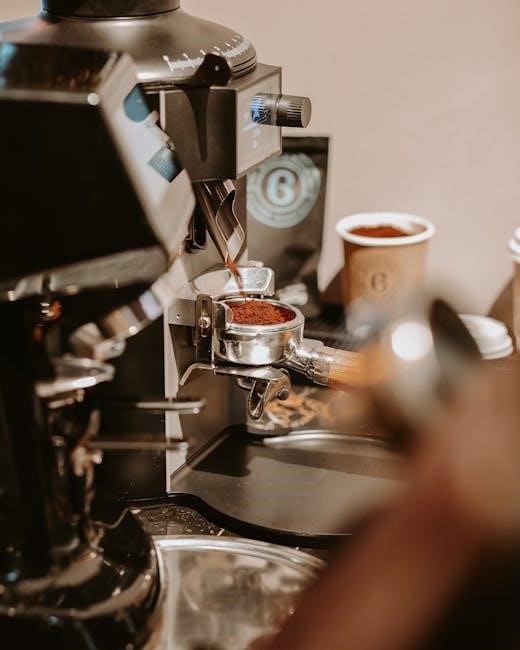
The Science Behind Coffee Grinding
The science behind coffee grinding involves understanding chemical reactions, particle size distribution, and heat management, all of which significantly impact flavor extraction and overall coffee quality.
Understanding the Chemistry of Grind
Understanding the chemistry of grind reveals how particle size and distribution impact extraction. Smaller particles increase surface area, accelerating extraction rates but risking over-extraction. The Maillard reaction, triggered during grinding, alters flavor compounds. Heat generated by burrs or blades can degrade volatile oils, affecting aroma. Uniform grind size ensures balanced extraction, preventing under- or over-extraction. The solubility of coffee solids is maximized with optimal grind, releasing desired flavors and acids. Mastering grind chemistry is key to achieving a harmonious brew, as it directly influences the final flavor profile and overall coffee quality.
History of Coffee Grinders
From ancient mortar and pestle to modern electric burr grinders, the evolution reflects technological advancements over centuries, enhancing coffee culture and the pursuit of precise grinding for optimal flavor.
Evolution from Traditional to Modern Grinders
The journey of coffee grinders began with simple mortar and pestle tools, evolving to hand-cranked models in the 17th century. By the late 1800s, the first mechanical grinders emerged, offering improved efficiency. The 20th century introduced electric grinders, revolutionizing home and commercial use. Modern grinders now feature advanced burr designs, precise grind control, and automation. This evolution reflects a commitment to enhancing flavor extraction and user convenience, making high-quality coffee accessible to everyone. Each innovation has played a pivotal role in shaping coffee culture worldwide.
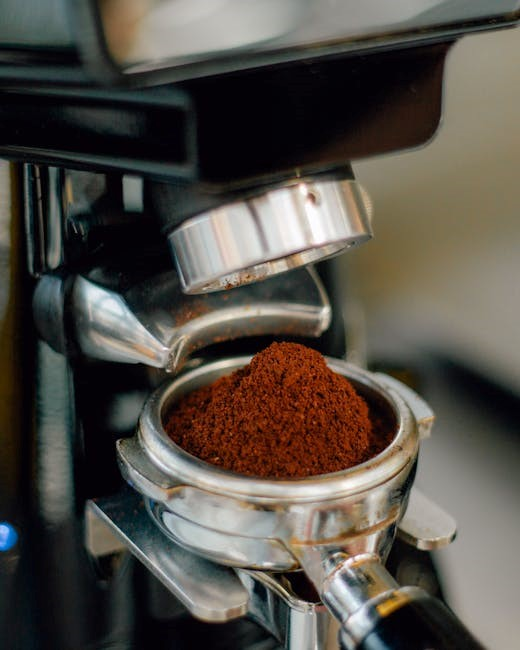
Environmental Impact of Coffee Grinding
Coffee grinding contributes to environmental concerns through energy consumption and waste generation. Eco-friendly practices, like using manual grinders and composting grounds, help reduce its ecological footprint significantly.
Sustainability in Coffee Grinding Practices
Sustainability in coffee grinding involves eco-friendly practices to minimize environmental impact. Opting for manual or energy-efficient electric grinders reduces energy consumption. Choosing sustainably sourced, fair-trade, and organic coffee beans supports ethical farming. Composting coffee grounds diverts waste from landfills and enriches soil. Additionally, selecting grinders made from recyclable materials and buying beans in bulk or biodegradable packaging further reduces waste. Encouraging manufacturers to adopt eco-conscious designs and materials also promotes sustainability. By adopting these practices, coffee enthusiasts can enjoy their brew while contributing to a healthier planet and supporting responsible agriculture. Sustainability enhances both the flavor and conscience of coffee grinding.

Pairing Grinders with Coffee Makers
Pairing grinders with coffee makers ensures optimal brewing. Burr grinders are ideal for espresso machines, while blade grinders suit drip coffee makers. Compatibility enhances flavor and efficiency.
Matching Your Grinder to Your Brewing Method
Matching your grinder to your brewing method is crucial for achieving the perfect cup. Different brewing techniques require specific grind sizes; For instance, espresso demands a fine grind, while French press needs a coarse grind. Burr grinders are ideal for precise control, especially for espresso and pour-over methods, as they produce consistent particles. Blade grinders are better suited for coarser grinds, such as those used in drip coffee makers or cold brew. Ensuring compatibility between your grinder and brewing method ensures optimal extraction and flavor. Experiment with settings to find the perfect balance for your preferred brew.
Coffee Grinding as a Gift
Gifting a coffee grinder is a thoughtful way to enhance someone’s coffee experience. It’s a practical present for coffee enthusiasts, offering personalization and daily enjoyment.
Selecting the Perfect Grinder for Others
Choosing the right grinder for someone involves considering their budget, coffee habits, and preferred brew methods. Opt for a grinder that balances quality and ease of use. Manual grinders are ideal for casual drinkers, while electric grinders suit daily enthusiasts. Ensure the grinder offers adjustable grind sizes to accommodate various brewing techniques. Durability and maintenance are also key factors—stainless steel burrs are a great choice for longevity. Pairing the grinder with a bag of freshly roasted beans adds a thoughtful touch. Consider their kitchen style and preferences for a personalized gift.

FAQs About Coffee Grinding
FAQs About Coffee Grinding answers common questions about freshness, grind size, and more to enhance your coffee experience. Discover tips and solutions for everyday grinding challenges.
Common Questions Answered
What grind size is best for my brew method? How do I ensure freshness? Can I grind other spices? These questions and more are addressed here. Discover practical solutions and expert tips to refine your grinding technique. Learn how to maintain your grinder, troubleshoot common issues, and explore the best practices for storing beans. Whether you’re a novice or an enthusiast, this section provides clear answers to help you master coffee grinding and elevate your daily cup. Gain confidence in your brewing process with these essential insights.
Mastering coffee grinding transforms your brewing experience. Fresh, precisely ground beans elevate flavor and aroma. Experiment, stay curious, and savor the perfect cup every time. Happy grinding!




Leave a Reply
You must be logged in to post a comment.